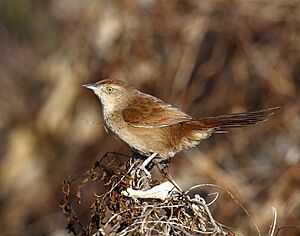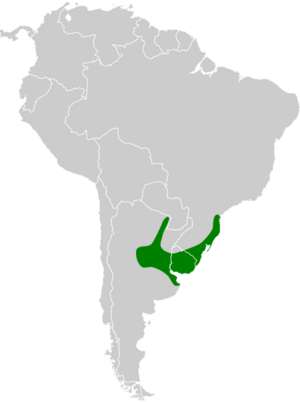Freckle-breasted thornbird facts for kids
The freckle-breasted thornbird (Phacellodomus striaticollis) is a small bird that lives in South America. It belongs to the ovenbird family, which is known for building unique nests. You can find this bird in countries like Argentina, Brazil, and Uruguay. It might also live in Paraguay.
Quick facts for kids Freckle-breasted thornbird |
|
|---|---|
 |
|
| Conservation status | |
| Scientific classification | |
| Genus: |
Phacellodomus
|
| Species: |
striaticollis
|
 |
|
| Synonyms | |
|
Anumbius striaticollis |
|
Contents
About the Freckle-breasted Thornbird
Scientists first described the freckle-breasted thornbird in 1838. This happened in Uruguay. It is a unique type of thornbird. There are no different kinds (subspecies) of this bird.
What Does It Look Like?
The freckle-breasted thornbird is a medium-sized bird. It is about 16 to 20 centimeters (6 to 8 inches) long. It weighs about 24 to 27 grams (0.8 to 0.9 ounces). Both male and female birds look the same.
It has a light brownish face. A faint light brown stripe goes above its eye. Its head is brownish chestnut with small white spots. Its back is a dull reddish brown. The lower back and tail feathers are a bit lighter reddish brown.
Its wings are mostly brown. The main flight feathers have reddish edges. The tail feathers are dull reddish-brown. The bird's throat is a dull white. Its chest is light brownish with pale streaks. It also has dark reddish speckles, like freckles! Its belly is light brownish white. The sides and under its tail are dull gray-brown.
The bird's eye is yellow or light orange. Its beak is dark on top and gray underneath. Its legs and feet are gray or greenish gray. Young birds have a less reddish back than adult birds.
Where Does It Live?
The freckle-breasted thornbird lives in several parts of South America. You can find it in northern Argentina. It also lives in southern Brazil and most of Uruguay. It might be in Paraguay too, but scientists are still checking.
This bird likes many different places. It almost always lives near water. You can find it in thick bushes along rivers. It also lives in forests along waterways. It likes the edges of marshes and dry scrublands. It can live from sea level up to about 700 meters (2,300 feet) high.
Bird Behavior
Staying in One Place
The freckle-breasted thornbird does not migrate. It stays in the same area all year long.
What It Eats
This bird eats many different kinds of insects. This includes beetles, grasshoppers, and scale insects. It usually looks for food in pairs. It finds its prey by picking it off the ground. It also searches on plants, up to the lower parts of trees.
Reproduction and Life Cycle
The freckle-breasted thornbird lays eggs in the spring and summer. This is usually from August to February. They are monogamous, meaning one male and one female pair up. Sometimes, they have two groups of babies in one season.
They build a special nest. It is shaped like an oval and made of thorny sticks. The nest can be about 30 centimeters (1 foot) high. It can be about 50 centimeters (1.6 feet) long. Inside, they line a chamber with soft plant material.
They hang their nest from the end of a tree branch. It is usually 1 to 3 meters (3 to 10 feet) above the ground. Often, the nest hangs over water. They usually lay three or four eggs. Sometimes they lay two or five eggs. The eggs hatch in about 16 days. The young birds leave the nest about 12 to 13 days after hatching.
Its Song and Calls
The freckle-breasted thornbird has a unique song. It starts with a few low notes that go up. Then it has three or four loud, sharp notes that go down. It sounds like "psep, psep, psep-kleek, kleek, kleek." When it senses danger, its alarm call is a series of squeaky ticking sounds.
Conservation Status
The IUCN (International Union for Conservation of Nature) says the freckle-breasted thornbird is a "Least Concern" species. This means it is not in danger of disappearing. It lives in a large area. Scientists believe its population size is stable. No major threats have been found for this bird. It is considered common in many places. It also lives in several protected areas.


